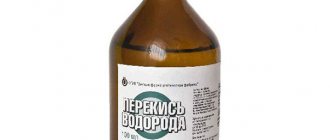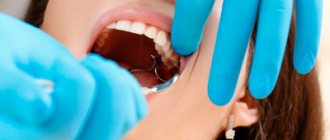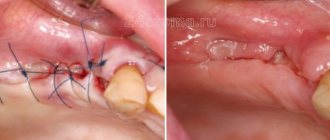Cleaning the tooth canals is a procedure for removing microparticles of the inflamed pulp from the roots, i.e. affected tissues. This is a particularly labor-intensive process, since the final effect of caries treatment depends on the quality of the work.
Clinical case: a patient has caries that has developed into pulpitis. When opening the tooth, the dentist diagnosed an infection and a severe inflammatory process; it was recommended to remove dead pulp tissue from the roots. If the work is not performed perfectly, an infection gets into the roots, a filling is placed on top, and the pathological process already develops under a thick layer of filling material. The toothache does not subside, the patient goes to the doctor again or endures the pain, quenching it with medications, and eventually loses the tooth. That is why, in case of caries, pulpitis and other problems, it is important to contact trusted doctors who perform high-quality root cleaning. It is advisable for the dentist to work with a microscope - multiple magnification allows you to monitor the process of cleaning the canals from remnants of pulp tissue.
One tooth may have two or more tubules, which are localized in the layers of the periodontium. The main task of the canals is to be a connecting link between the crown pulp and the nerves.
More than 10 years ago, deep caries and advanced pulpitis were the reasons for removing a unit, but now, thanks to effective cleaning and treatment of the canals, it is possible not only to preserve the crown, but also to restore its integrity to an ideal result.
When is tooth canal cleaning necessary?
Here are three common cases when a patient is required to have canal cleaning:
- Before installing the prosthesis on the tooth, the unit is depulped and ground down so that a crown can subsequently be installed on it;
- When diagnosing pulpitis (inflammation of pulp tissue). Usually pulpitis is a consequence of advanced caries and infection. The problem is accompanied by acute pain; it is painful for the patient to chew on the side of the pathological tooth, which indicates severe inflammation inside the tooth;
- If a person has been diagnosed with periodontitis - inflammation of the tissues around the tooth. Usually the problem is a consequence of untreated caries and a dynamically spreading infection.
Internal tissues and pulp become inflamed due to the penetration of pathogenic microorganisms. They can also get inside due to mechanical injuries (chipping off a piece of a tooth, splitting a crown due to a blow or fall, tooth dislocation), gum disease.
Note! Pain is not always the only signal to remove the pulp and clean the tubules of dead granules. Very often, cell death occurs without pronounced symptoms, when the tooth stops hurting, and the inflammatory process is already actively developing inside it. A visit to the dentist and a complete examination of the oral cavity will help you understand that there is a purulent-inflammatory process in the tooth.
It is important to thoroughly clean the canals from pulp residues, since pathogenic microflora will still provoke purulent-inflammatory processes. Therefore, it is advisable to remove inflamed tissue not only from the canals, but also from the crown part of the tooth.
In particularly complex and advanced cases, partial pulp resection is prescribed. If the dentist does not consider this method, unfortunately, the tooth is removed.
Dentistry for those who love to smile
+7
Make an appointment
The best remedies for toothache
There are many ways to quickly relieve pain at home if there are no pills. Some of them can be used immediately, while others make sense to prepare in advance.
Top 10 funds
- Rinse with a warm (not hot or cold!) solution of salt and soda. Dissolve one teaspoon of salt and soda in a glass of water, rinse every 20-30 minutes. The pain will go away gradually.
- Apply a crushed clove of garlic. You can use garlic mixed with salt.
- Hydrogen peroxide solution You can use a ready-made solution directly from the pharmacy, but it has a specific taste. For this reason, it is better to dissolve 1-2 tablespoons in a glass of water. Do not swallow – the substance is a strong oxidizing agent.
- Strong alcohol Rinse your mouth vigorously with a sip of vodka or cognac on the affected side. In the case of an open canal, a sharp pain may initially appear, which will quickly subside. Not to drink.
- Ice Take a piece of ice from the freezer and wrap it in a napkin or towel. Apply to the sore cheek. If there is no ice, take a piece of frozen meat. It is important to avoid hypothermia.
- Infusion of chamomile or sage Chamomile is brewed at the rate of one or two tablespoons per glass of boiling water and infused. Sage is taken in the same proportions and kept in a water bath for 15 minutes. Rinse your mouth with warm infusion continuously for 20 minutes. To consolidate the effect, the procedure is repeated after 15 minutes. The method is one of the most effective.
- Apple cider vinegar is also a good pain reliever. Moisten a piece of cotton wool and apply it to the tooth.
- A time-tested method is to place a piece of unsalted lard between the cheek and the sore area. If the lard is taken out of the freezer, the cut piece should be warmed to room temperature.
- Ketorol, one of the best drugs that relieve pain. There are restrictions on quantity - no more than three tablets per day. It is not recommended to take for peptic ulcers, gastrointestinal diseases, shortness of breath, bronchospasm, stroke. Pregnancy and breastfeeding are also contraindications.
- Analgin Despite all the negative attitudes towards it, it will quickly help relieve toothache for a while. Not recommended for pregnant and lactating women.
- Raw beets Apply a piece to the sore spot.
- Propolis tincture Moisten a cotton swab with the solution and apply to the tooth, but not to the gum (you may get burned). The product is not suitable for those who have an allergic reaction to honey and its products.
- Take a small onion, chop it very finely. Wrap the resulting mass in gauze (cambric or washed thin chintz) and place it in the ear, which is located on the other side of the diseased area.
- Valerian or horse sorrel leaves. Picked leaves can be chewed or applied to the tooth. The product is a good help when relaxing outdoors in the summer.
- Peppermint The plant has excellent analgesic and vasodilating properties. To reduce pain, just chew the leaves.
- Vodka with garlic Grate two cloves of garlic and mix with 30 ml of vodka. Rinse your mouth vigorously on the affected side. Be sure to spit out the mixture.
- Aspen decoction Pour boiling water over a tablespoon of small wood chips (a little more than a glass), boil for 15 minutes, leave for at least half an hour. Then rinse your mouth every 15-20 minutes until the pain stops completely.
- Rinsing with oak bark decoction is prepared in the same way as aspen decoction.
- Clove oil Apply a cotton wool soaked in oil to the tooth.
- Fir oil A few drops should be applied to a cotton swab or disk and applied to the sore spot. For “blurred”, non-localized pain, you can inhale the vapor.
- Tea tree oil We also apply it to a cotton swab and apply it to the problem area. If necessary, we do a mini-inhalation.
- Plantain Take a fresh plantain leaf and rinse it well. You can knead it, you can chew it. Apply the resulting pulp to the sore spot. As an option, brew the herb (1 tablespoon per glass) and rinse with a warm solution.
- Plantain root Pull out the plantain bush, rinse the roots well and dry. Place a few roots between the tooth and cheek. The second option is to insert the root into the ear canal on the sore side.
- Cinnamon Pour cinnamon powder into warm water to form a dense mass. Apply the resulting paste to the tooth and adjacent gum. Improvement is noticed almost immediately, and after a few minutes the pain goes away.
- Turnip decoction Pour boiling water over two tablespoons of chopped vegetable and simmer for 15 minutes over low heat. Cool until warm and rinse.
- Mint drops Moisten a cotton pad or cotton ball and apply to the tooth.
- Camphor oil is great for helping not only with toothache, but also with gum abscesses. The moistened cotton wool is applied to the tooth or gum. It draws out pus very quickly.
- Place a clove of garlic on the wrist on the side opposite the painful area. Wrap it with a bandage or secure with a bandage.
- Onion peel decoction Remove the peel from a medium onion and pour boiling water over it. Leave until the solution becomes warm. Start rinsing. The product is really very effective - three procedures every 20-30 minutes are enough.
- A piece of incense You should try to place it in the hole of the tooth.
- Dissolve 3 tablets of mumiyo in a glass of warm water, rinse your mouth
- Heart drops Corvalol, valocordin, valoserdin. Apply a moistened piece of cotton wool to the sore tooth.
Folk remedies
Preparing for channel cleaning
To assess the condition and structure of the root system, the patient is prescribed a preliminary diagnosis:
- CT scan;
- radiography;
- radiography;
After this, the dentist chooses a cleaning tactic and a special tool for the job.
Before opening the coronal part, local anesthesia is administered, since in a state of inflammation, internal structures can provoke acute pain. In this case, the dentist administers the anesthetic using the following methods:
- point or infiltration, that is, when injections are made into the projection of the apexes. An injection into the cancellous bone using the same infiltration method will also numb the area well;
- The conduction technique involves anesthesia of the nerve branch that surrounds the neighboring units. Anesthesia also affects some of the soft tissues, so after the injection and treatment, the patient may continue to experience unpleasant sensations in the immobilized part of the mouth for a long time.
Medicines to relieve toothache
Pharmacological drugs will help relieve pain faster and more effectively than folk remedies. But there are some disadvantages here - contraindications and allergies to any of the components.
Each personal first aid kit has its own set of painkillers. Some are accustomed to using state-of-the-art, expensive drugs, while others still prefer familiar and familiar means. Also read our article about the best tablets for toothache.
Good help to get rid of toothache:
Psychological techniques
Here you will have to concentrate a little and try to pull yourself together.
Massage
You should start with the hand that is located on the side of the diseased tooth.
Prepare ahead of time at home or let it sit just in case
Not a single folk remedy, even the best one, can eliminate the source of pain. As a temporary option, wait until the morning if you get it at night, or as a pain reliever for acute symptoms.
Will root canal cleaning save a tooth that is more than 50% destroyed?
Yes, quite, but instead of installing a composite filling, it is recommended to install a microprosthesis or a ceramic crown. The only difference is in the final stage of the operation.
Clinical case: the patient was diagnosed with advanced caries, which developed into pulpitis. The tooth is badly damaged, but the root is intact. The dentist removes necrotic tissue, qualitatively treats the canal passages, cleans them under a microscope, and then places a microprosthesis or a full-fledged crown.











